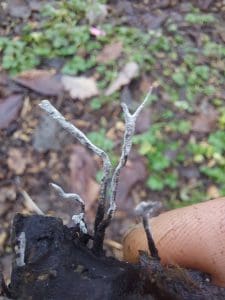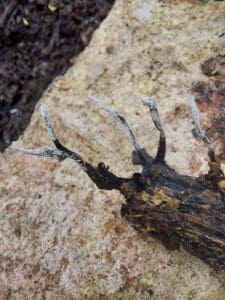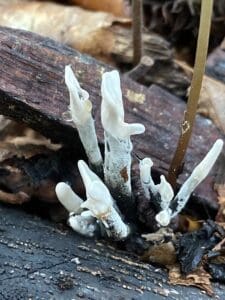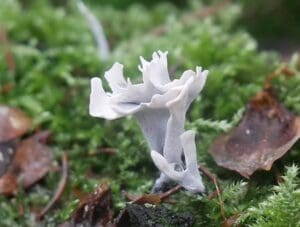Candlesnuff fungus / Spring / Summer / Autumn / Winter / Inedible
The Candlesnuff Fungus, scientifically known as Xylaria hypoxylon, is a remarkable ascomycetous fungus that graces the woodland with its intriguing presence throughout the year, but particularly during the colder months of late autumn and winter.
This enigmatic species, also referred to as the Stag’s Horn Fungus or Carbon Antlers, boasts a distinctive appearance, often appearing as upright stroma with black, elongated branches sporting whitened tips.
Despite its captivating visual allure, this fungus is not generally considered to be edible.
Scientific Name
Xylaria hypoxylon
Common Names
Candlesnuff fungus, Candlestick fungus, carbon antlers, stag’s horn fungus
Family
Xylariaceae
Habitat
They are a strong saprotobe that specialises in consuming the polysaccharides and other compounds of timber that bind the cellulose and lignin together to form what we recognise as wood.
They are found in groups on dead and rotting wood, and on stumps and branches of all sorts of trees.
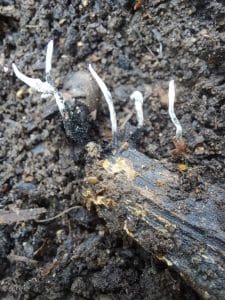
Description
Very common and easy to ID, more important to the ecosystem than to hungry foragers.
Identifying Features:
Cap & Fruiting Body
The fruiting body of the candlesnuff fungus is simple and pretty unmistakable. It’s a black, stick-like structure that is hairy at the base and powdery white at the tip. The stem can become flattened and branched in a fork like an antler, hence the other name of ‘Stag’s Horn’. Sometimes when you gently flick them they release a small cloud of spores.
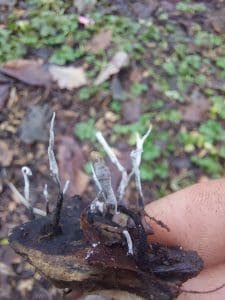
Smell:
No distinct smell.
Spores:
Black to white.
Known hazards
None known.
Potential lookalikes
They are quite distinctive, but the most similar looking mushroom is the Beechmast Candlesnuff (Xylaria carpophila), which grows on old beech masts.
Uses:
In food
They’re not thought to be toxic but they are inedible due to being tough and insubstantial.
I’m certain if you battered and deep fried them, like most things, it would be quite tasty.
Extra Notes
The scientific name is derived from the Greek words hypo meaning “below”, and xylon, meaning “wood.
The Candlesnuff fungus is a bioluminescent, in a really dark place or with a UV torch, it can be seen to emit light as phosphorus within the mycelium reacts with oxygen and other chemicals.
Interesting Facts About the Candlesnuff Fungus:
- Bioluminescent Nature: Contrary to its name, the Candlesnuff Fungus is bioluminescent, emitting a ghostly greenish light in dark environments. While the luminescence is relatively weak, it adds to the mystique surrounding this fascinating fungus1.
- Habitat and Ecological Role: The Candlesnuff Fungus is a saprobic species that thrives on fallen branches and rotting stumps of broad-leaf trees, occasionally even on pine stumps. It specializes in consuming polysaccharides, contributing to the breakdown of wood and the subsequent nutrient-rich environment for other organisms
- Chemical Compounds: This fungus harbors a variety of chemical compounds, some of which exhibit cytotoxic and anti-tumor properties. From xylarial A and B to pyrone derivatives and cytochalasins, the Candlesnuff Fungus presents a wealth of chemical complexity with potential medicinal implications
- Taxonomic History and Synonyms: Initially named Clavaria hypoxylon by Carl Linnaeus in 1753, it was later transferred to the genus Xylaria and given the current name Xylaria hypoxylon. Its unique epithet “hypoxylon” alludes to its affinity for wood, as it consumes the polysaccharides present in timber and wood.
The Candlesnuff Fungus, with its bioluminescence, ecological significance, and medicinal potential, stands as a captivating subject for both nature enthusiasts and researchers, inviting us to delve into the intricate world of fungi and the profound impact they have on their ecosystems.
References:
https://www.wildlifetrusts.org/wildlife-explorer/fungi/candlesnuff-fungus



